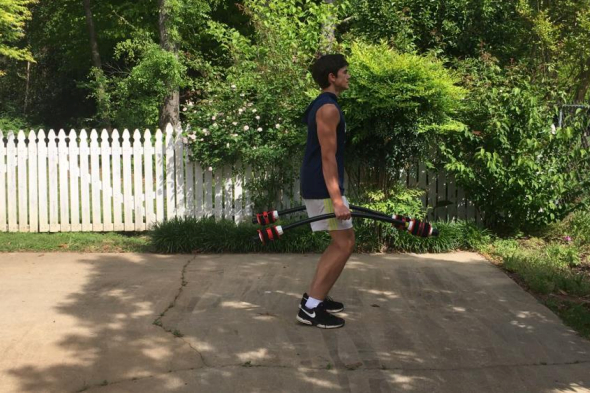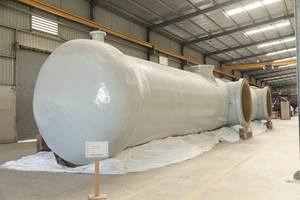
For sports that require jumping or running, athletic training will likely involve dynamic movements that not only strengthen certain leg muscles but activate the fast-twitch muscle fibers to enable more power and higher performance. One composites-based training solution, called a Jump Stick, promises athletes of all levels a safe, effective solution for more dynamic leg muscle training.
Gordon Brown, president of Flexi-StiX LLC (Anderson, S.C., U.S.), began his career in the textile industry as an industrial engineer at Burlington Industries in 1968. Since then, he has worked in various capacities at textile and composites companies. While working at pultrusion company Morrison Molded Fiber Glass Co. (now Strongwell, Bristol, Va., U.S.), Brown became interested in the use of pultruded fiberglass rods in gym equipment, for their ability to add “bendable resistance,” he says. Fiberglass pultruded rods and bars offer tailored bending resistance with the flexibility to train an athlete’s muscles.
Inspired by fiberglass composite pole vaults, exercise equipment and the Bodyblade — an oscillating therapy and exercise bar developed in the 1990s by physical therapist Bruce Hymanson — Brown developed and patented a bendable bar comprising rectangular rods of pultruded fiberglass/epoxy contained within a flexible PVC tube.
Brown explains that in his patented process, he inserts long, thin fiberglass/epoxy-pultruded bars of rectangular cross-section into a round tube, where they fit securely but loosely within the tube. When the device is bent or shaken during a training exercise, the flexible tube oscillates around the fiberglass rod. “Having the fiberglass shapes float inside the extruded tube allows for the shapes to automatically orient themselves so that they will bend around the major axis of the fiberglass pultruded shape when the product is bent,” he says. The rectangular cross-section is key to the rods staying in place, he adds. “When you deal with products that flex or oscillate, you have to be concerned with flex fatigue, and one way to get sufficient bending stiffness with good flex fatigue life is to use a rectangular shape,” he explains.

In 2003, Brown started Flexi-StiX LLC to market and sell his inventions. The first commercial iteration of Brown’s design was licensed to Body Bar Inc. (Louisville, Colo., U.S.), a company that makes bars for step aerobics, as a more flexible alternative to the company’s traditional steel bars. In 2012, Brown developed and commercialized the Tsunami Bar along with Clemson University (S.C., U.S.) strength and conditioning coach David Abernathy. Developed in several size and strength levels, the Tsunami Bar is marketed as a flexible barbell that can be weighted using traditional disc weights and used in the same manner as traditional steel barbells.
Brown says, “I consider myself to be an expert in the use of composite devices to help train athletes to perform at a higher level. I have learned from exercise physiologists that to create ‘explosive strength’ or power in athletes, one must provide a controlled amount of added resistance to the muscles that are being trained during fast movements.”
See Instagram post from Furman University (Greenville, S.C., U.S.) below for a demonstration of the Jump Sticks in use:
In 2020, Brown developed his most recent invention, the Jump Stick, which is a version of his flexible composite bar specifically used to activate the fast-twitch muscle fibers in the legs so that athletes can train to jump higher or move with greater agility. The athlete holds a Jump Stick in each hand while jumping, using the weight and resistance from the bar to train the leg muscles to fire faster.
Each Jump Stick, which weighs under five pounds, when bent into a U-shape, is said to produce about 40 pounds of bending resistance. Brown says that if an athlete jumps five times up and down as fast as they can putting as much force into the ground as they can using the Jump Sticks, they will jump between 1 and 5 inches higher on their next standing vertical jump. For the Jump Sticks, one to three fiberglass pultruded shapes, all of which are 0.187-inch thick and 0.5-inch wide, and about a half-inch shorter than the tube itself, fit into the tubing depending on the weight and stiffness needed. Flexi-StiX uses Glasforms pultruded rods supplied by Avient (formerly PolyOne, Avon Lake, Ohio, U.S.). “When in use, all of the shapes will move to bend around their major axis as the device is bent when the athlete jumps rapidly. If you are familiar with leaf springs on an automobile, my use of multiple fiberglass pultruded shapes is similar,” Brown says.
To test and validate the Jump Sticks, Brown has been working with local high schools and Furman University (Greenville, S.C., U.S.) coaches and athletes. Currently, the product is available in two sizes, 35 inches and weighing 2 pounds with the addition of rubber weights, and 49 inches with 4 pounds of weight. The shorter and lighter version is ideal for young athletes, and the longer, heavier version is designed for college or pro athletes.
Related Content
Robotized system makes overmolding mobile, flexible
Anybrid’s ROBIN demonstrates inline/offline functionalization of profiles, 3D-printed panels and bio-based materials for more efficient, sustainable composite parts.
Read MoreIndustrial equipment manufacturer expands global footprint, reaches into new markets
India-based CW Top Shops honoree EPP Composites reflects on a recently successful vertical filament winding application and new pultruded FRP rebar capabilities, as well as future opportunities.
Read MorePulFlex introduces pultruded Flex Connect
Fiberglass T-slot, primarily used for automation, framing and other quick setup systems, competes with aluminum alternatives.
Read MoreSeat frame demonstrates next-generation autocomposites design
Light weight, simplified/cost-effective manufacturing, passenger comfort and safety informed materials and process innovations and won awards for the 2022 Toyota Tundra‘s second-row seat frame.
Read MoreRead Next
Developing bonded composite repair for ships, offshore units
Bureau Veritas and industry partners issue guidelines and pave the way for certification via StrengthBond Offshore project.
Read MoreAll-recycled, needle-punched nonwoven CFRP slashes carbon footprint of Formula 2 seat
Dallara and Tenowo collaborate to produce a race-ready Formula 2 seat using recycled carbon fiber, reducing CO2 emissions by 97.5% compared to virgin materials.
Read More“Structured air” TPS safeguards composite structures
Powered by an 85% air/15% pure polyimide aerogel, Blueshift’s novel material system protects structures during transient thermal events from -200°C to beyond 2400°C for rockets, battery boxes and more.
Read More

.jpg;width=70;height=70;mode=crop)





















